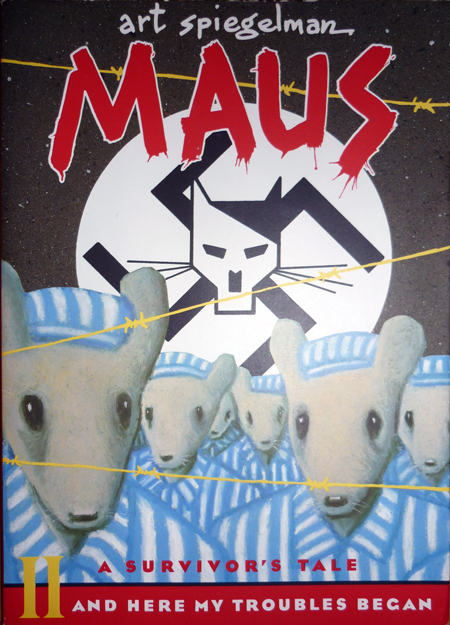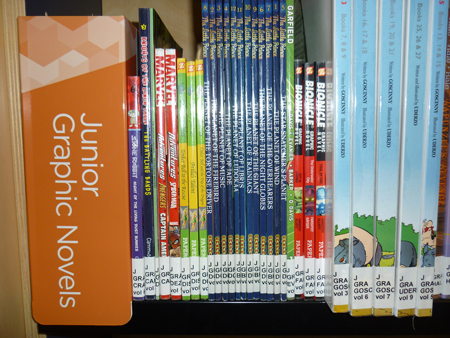Issue 91
Term 4 2014
Graphic novels: providing a different perspective
Karen Gray, a primary teacher librarian, looks at how graphic novels can be used across the curriculum and how the teacher librarian must advocate their value via sound professional knowledge of literacy and literature.
Graphic stories have been told since time immemorial. From the 17,000-year old cave paintings of Lascaux, the hieroglyphics of Ancient Egypt, the tapestry panels of the Middle Ages, and the invention of the printing press; all had a graphic story to tell.
Today, manga, comics, comic books, graphic literature, graphic stories, and graphic novels are analogous to the same form of text. However, an enduring prejudice towards these texts as sub-standard literature has been a difficult issue to overcome.
William Eisner's (1978) Contract With God and Other Tenement Stories was seen as a turning point. An attitude change was further cemented when the 1991 Pulitzer Prize was awarded to Art Spiegelman for Maus, which tells of his family's experiences in the Holocaust. Graphic novels now tell richer and more extended stories that deal with serious topics (Cromer & Clark, 2007). They are also a bridge to their text based counterparts (Lee, 2007). For high school students manga interpretations of Shakespearian works such as Hamlet or Romeo and Juliet provide such a bridge.
The graphic novel format has also been a platform for the popular trend of fusion texts. These books merge the features of comics, graphic novels and prose (Evans, 2013). Kinney's (2008) Diary of a Wimpy Kid series and Pichon's (2011) Tom Gates series are examples of this hybrid text.

Maus II:a survivor's tale: and here my troubles began by Art Spiegelman
What Value Do Graphic Novels Add to the School Library Collection?
Students of the 21st century are inundated with visual images accessible on a range of devices and formats. With a prolific online world, Kunkle (2004) identifies similarities between reading a graphic novel, the interactivity contained in websites, and the importance of visual literacy skills in being able to navigate both. Graphic novels are considered multimodal texts that tap into the way students already learn.
The Australian Curriculum: English has a strong focus on visual literacy. Students are required to read and view a wide range of texts as a key outcome. Becoming visually literate means students read and interpret the purpose and intended meaning, as well as analyse, synthesise and evaluate the form, structure and features of visual texts (NSW English K-10 Syllabus 2012 Glossary). This implies the use of higher order thinking skills. For the first time recommended texts include graphic novels. DiCamillo's (2004) The Tale of Desperaux, a suggested text in the NSW English K-10 Syllabus, has been adapted into a graphic novel and film. This differentiates the curriculum and enables exploration of the text through various formats. Given this mandate it would be an expectation that a school library include graphic novels in its collection to support visual literacy.
Graphic novels support the varying learning needs of all students, which is another reason for their inclusion in the library. Students who are hearing impaired or diagnosed with autism use pictures as a way to understand and derive meaning (Kluth, 2008, p170). They also support students who experience difficulty visualising pictures in their head and motivate reluctant readers. Further comparisons have been drawn between graphic novels and Gardiner's Multiple Intelligences. Graphic novels provide a creative outlet for students with linguistic intelligence. Using graphic formats allows students to respond and express their knowledge and ideas in a creative way. Because of their layout there is an obvious connection for students with spatial intelligence. The visual elements of facial expressions, settings, lines, and shadings appeal to students whose strength is interpersonal intelligence, as they identify and empathise with the characters (Lyga, 2006).
The reading of any text involves interpretation. Sabeti (2012) conducted research into critical reading practices of an extra-curricular Graphic Novel Reading Group with Shaun Tan's (2007) novel, The Arrival. The aim was to determine the strategies applied when interpreting texts in English classrooms. Contrary to her assumptions she found that students used a wider range of strategies to interpret the graphic novel that went beyond their classroom experience. Sabeti saw that traditional teaching methods imposed limitations on students. Through both studies, students developed greater understanding of the political and social contexts conveyed through the novels and were able to empathise with the characters' experiences. Graphic novels enriched student learning.

Graphic novels in the collection
Graphic novels can be used across the curriculum to address artistic style and technique or complex issues of bullying, prejudice, coming of age, social justice and injustice, and triumph over adversity (Schwarz, 2006; Patrick, 2010). Social, economic and cultural contexts of different historic periods are visually reinforced through graphic novels that can be a tool to aid learning across the curriculum (Boerman-Cornell, 2013).
What is the Role of the Teacher Librarian?
The Australian School Library Association (ASLA, 2004) outlines three areas for standards of professional excellence for teacher librarians: professional knowledge; professional practice; and professional commitment. Including graphic novels in the library collection requires teacher librarians to have a thorough understanding of their school community, the curriculum, and the recreational interests of the users. Acceptance of graphic novels as legitimate reading sources within the school community may be an issue. The teacher librarian must advocate their value to the curriculum and student learning, as well as making them part of the school library collection to foster students' love of reading (Crawford, 2004).
It is up to the teacher librarian to have sound professional knowledge of literacy and literature for the teachers and students in their schools. (ASLA. 2004, 1.3) This professional knowledge means applying sound judgment in deciding which graphic novels to add to the collection, as 'not all graphic novels are equally useful' (Boerman-Cornell, 2013). A comprehensive collection policy is essential in sourcing professional reviews and recommendations to select and acquire graphic novels. Publisher guidelines should not be accepted at face value, as they do not always align with the school library's selection criteria (Lee, 2007). Like other resources in the collection graphic novels may be challenged and a rigorous process must be in place to review and resolve any objection.
Part of the teacher librarian's role is to support teaching and learning. Laycock (2007) believes teacher librarians are placed in a strong position to collaborate and lead planning and implementation of rich literacy programs. This includes the use of graphic novels as a means of differentiating the curriculum and meeting the diverse needs and reading interests of students across the school. There may be initial resistance, but collaborating with an interested working party is a step towards overcoming this. Carter (2009) suggests that teachers may be more willing to use graphic novels as curriculum supplements. It can be more effective to integrate graphic novels into existing units of work than reading them in isolation. Monitoring the impact of graphic novels on student learning and sharing this evidence with staff may gradually change perception.
Graphic novels have a valid place in today's school library collection as a literary form. They engage learning across the curriculum, support differentiation within the classroom and foster a dynamic reading culture.
References
- Asla.org.au, (2014). Standards of professional excellence for teacher librarians. [online] Available at: http://www.asla.org.au/policy/standards.aspx
- Boerman-Cornell, B. (2013). 'More than comic books'. Educational Leadership, [online] 70(6), pp.73-77. Available at: http://www.ascd.org/publications/educational-leadership/mar13/vol70/num06/More-Than-Comic-Books.aspx
- Carter, J.B. (2009). 'Going Graphic'. Educational Leadership, 66 (6), 68-73.
- Cromer, M., & Clark, P. (2007). 'Getting graphic with the past: Graphic novels and the teaching of history'. Theory & Research in Social Education, 35(4), 574-591.
- Evans, J. (2013). 'From comics, graphic novels and picture books to fusion texts: a new kid on the block!'. Education 3-13, [online] 41(2), pp.233-248. Available at: http://dx.doi.org/10.1080/03004279.2012.747788
- Kluth, P (2008). 'It was always with the pictures'. In N. Frey and D.Fisher, ed., Teaching Visual Literacy: Using Comic Books, Graphic Novels, Anime, Cartoons and More to Develop Comprehension and Thinking Skills. USA: Corwin Press.
- Kunkle, J. (2005). 'Standing in the Shadows of History'. Theory & Research in Social Education, 33(4), 548-552.
- Laycock, D. (2007). 'Going Graphic: Using graphic novels to engage boy's in school reading'. Access, 21(1), 13-17.
- Lee, A. (2007). 'Graphic Attraction–Graphic novels in libraries'. Connections, 62, 1-3.
- Lyga, A. (2006). 'Graphic Novels for (Really) Young Readers'. School Library Journal. [online] Available at: http://www.slj.com/2006/03/collection-development/graphic-novels-for-really-young-readers/#_
- NSW Board of Studies, (2012). NSW English K-10 Syllabus and Glossary. [online] Available at: http://syllabus.bos.nsw.edu.au/english/english-k10/glossary/
- Patrick, K. (2010). 'The invisible medium: comic studies in Australia'. Refractory, [online] 17. Available at: http://refractory.unimelb.edu.au/2010/07/18/the-invisible-medium-comics-studies-in-australia-kevin-patrick/
- Sabeti , S. (2012) 'Reading graphic novels in school: texts, contexts and the interpretive work of critical reading'. Pedagogy, Culture and Society, 20(2), 191-210.
- Schwarz, G. (2006). 'Expanding literacies through graphic novels'. English Journal, 95. 58-64.
Image credits
- Maus II: a survivor's tale: and here my troubles began by Art Spiegelman. © 1991 by Pantheon Books, a division of Random House LLC; Used by permission of Pantheon Books, an imprint of the Knopf Doubleday Publishing Group, a division of Random House LLC. All rights reserved.
- Graphic novels in the collection. Photography by Laura Armstrong. CC-BY-NC-SA.
